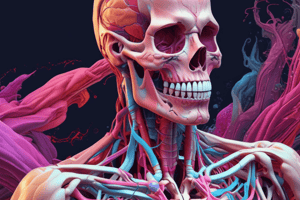Podcast
Questions and Answers
What is the primary focus of physiology?
What is the primary focus of physiology?
- The study of body structures
- The study of the microscopic structures in anatomy
- The study of the body's surface anatomy
- The study of how living organisms perform vital functions (correct)
Which of the following is NOT a form of gross anatomy?
Which of the following is NOT a form of gross anatomy?
- Surface Anatomy
- Systemic Anatomy
- Cytology (correct)
- Clinical Anatomy
What does developmental anatomy primarily describe?
What does developmental anatomy primarily describe?
- The relationships between different body regions
- The structure of organ systems
- The internal structures of cells
- Changes in form from conception to adulthood (correct)
Which term refers to the study of the body's surface in relation to underlying structures?
Which term refers to the study of the body's surface in relation to underlying structures?
Which level of organization is considered the simplest in the human body?
Which level of organization is considered the simplest in the human body?
What is the primary function of a positive feedback mechanism?
What is the primary function of a positive feedback mechanism?
Which division of the human body includes the head, neck, and trunk?
Which division of the human body includes the head, neck, and trunk?
What does the frontal plane divide the body into?
What does the frontal plane divide the body into?
What is the role of serous fluid in the ventral body cavity?
What is the role of serous fluid in the ventral body cavity?
Which of the following best describes the visceral serosa?
Which of the following best describes the visceral serosa?
Which of the following represents the correct order of levels of structural organization in the human body?
Which of the following represents the correct order of levels of structural organization in the human body?
What is the primary role of the control center in the homeostatic regulation process?
What is the primary role of the control center in the homeostatic regulation process?
Which of the following is NOT one of the four basic types of tissues?
Which of the following is NOT one of the four basic types of tissues?
What does homeostasis refer to in biological systems?
What does homeostasis refer to in biological systems?
Which mechanism is characterized by the output shutting off or reducing the original stimulus?
Which mechanism is characterized by the output shutting off or reducing the original stimulus?
Which life function involves breaking down substances to produce energy?
Which life function involves breaking down substances to produce energy?
What is the purpose of autoregulation in homeostatic mechanisms?
What is the purpose of autoregulation in homeostatic mechanisms?
Which of the following survival needs is essential for producing energy in cells?
Which of the following survival needs is essential for producing energy in cells?
Study Notes
Introduction to the Human Body
- Anatomy: Focuses on the structure of the human body, both internal and external.
- Physiology: Examines how living organisms carry out vital functions.
- Gross Anatomy vs. Microscopic Anatomy: Gross anatomy looks at large structures, while microscopic anatomy studies smaller components not visible to the naked eye.
Types of Anatomy
- Gross Anatomy: Divided into several forms:
- Surface Anatomy: Examines the body’s external features and their relation to internal structures.
- Regional Anatomy: Focuses on specific areas of the body and their organizational structures.
- Sectional Anatomy: Analyzes cross-sections of tissue or organs to understand their relationships.
- Clinical Anatomy: Pertains to subspecialties relevant to clinical practice.
- Systemic Anatomy: Looks at the anatomy of organ systems, grouping organs by functional systems.
- Developmental Anatomy: Studies changes in form from conception to adulthood.
Microscopic Anatomy
- Deals with structures that require a microscope to be observed, divided into:
- Cytology: Looks at cellular structures, the fundamental units of life.
- Histology: Investigates tissues and their organization.
Levels of Structural Organization
- Chemical Level: Atoms combine to form molecules.
- Cellular Level: Molecules form cells.
- Tissue Level: Cells group together to form tissues (epithelial, connective, muscular).
- Organ Level: Tissues collaborate to create organs.
- Organ System Level: Organs work together as organ systems.
- Organism Level: Organ systems combine to form a complete organism.
Necessary Life Functions
- Maintaining life boundaries: Keeps internal environments distinct from external environments.
- Movement: Action of muscles and ability to change location.
- Responsiveness/Excitability: Ability to detect and respond to stimuli.
- Digestion: Breaking down food and absorbing nutrients.
- Metabolism: Includes catabolism and anabolism, as well as cellular respiration.
- Excretion: Removal of wastes.
- Reproduction: Capability of producing offspring.
- Growth: Increase in size and complexity.
Survival Needs
- Nutrients: Essential for energy and cell building.
- Oxygen: Necessary for cellular respiration.
- Water: Vital for homeostasis.
- Normal body temperature: Maintains optimal enzyme activity.
- Appropriate atmospheric pressure: Required for effective breathing and gas exchange.
Homeostasis
- The body's ability to maintain stable internal conditions amidst external changes.
- Greek origin: "Homeo" means similar, and "stasis" refers to a state of standing.
- Failure to maintain homeostasis can result in illness or death.
Mechanisms of Homeostatic Regulation
- Autoregulation: Adjustments made by a system in response to environmental changes.
- Extrinsic regulation: Adjustments made by the nervous system or endocrine system.
Process of Homeostatic Regulation
- Receptor: Detects environmental changes and sends information via afferent pathway.
- Control Center: Evaluates input and determines response, sending commands through efferent pathway.
- Effector: Pairs with the control center to produce an effect that mitigates change.
Feedback Mechanisms
- Negative feedback: Counteracts change to maintain stability, reducing stimulus intensity.
- Positive feedback: Enhances the original stimulus, accelerating response.
Anatomical Regions and Body Organization
- The body is divided into two main divisions:
- Axial: Comprises the head, neck, and trunk.
- Appendicular: Involves limbs and their attachments to the trunk.
Anatomical Terms of Direction
- Essential for describing locations in relation to one another within the body.
Body Planes and Sections
- Sagittal Plane: Divides the body into right and left sections.
- Frontal Plane: Separates into anterior (front) and posterior (back) portions.
- Transverse Plane: Divides into superior (upper) and inferior (lower) sections.
- Oblique Section: Cuts made diagonally between horizontal and vertical planes.
Body Cavities and Membranes
- Ventral Body Cavity: Contains serous membranes that protect organs.
- Parietal Serosa: Lines cavity walls.
- Visceral Serosa: Covers internal organs within the cavity.
- Serous Fluid: Lubricates and reduces friction between organs.
Studying That Suits You
Use AI to generate personalized quizzes and flashcards to suit your learning preferences.
Related Documents
Description
This quiz covers the basics of human anatomy and physiology, including definitions, differences between gross and microscopic anatomy, and the levels of organization within the body. It is designed for students learning about human biology and serves as an essential foundation for understanding more complex concepts.




